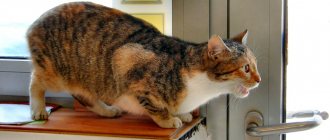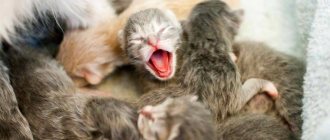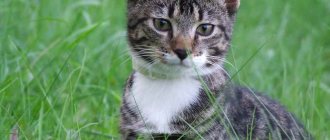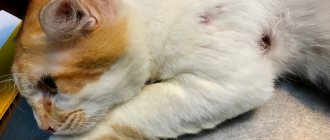When kittens begin to move in the belly of a pregnant cat, this indicates that the pregnancy itself is proceeding without problems, which is why it is important to monitor the condition and behavior of the pet, especially if she is bearing offspring for the first time. Typically, movement occurs at 6 weeks, when the kittens' muscular and nervous systems are developing. In this way they warm up the motor system.
How to determine pregnancy
Visually, a cat’s pregnancy can be suspected with an increase in the abdomen and appetite. It is imperative to see a doctor, because there are a number of pathologies that can also manifest themselves. And for further diagnosis, an ultrasound of the abdominal cavity will be required (1). Pregnancy can also be seen on x-rays.
1st – 3rd week of pregnancy in a cat
In the early stages it is very difficult to determine. Only at the beginning of the 3rd week is it possible to see something on an ultrasound, but the cat itself does not show any external signs of pregnancy. Therefore, you will be surprised by the middle of the term, when the cat begins to show obvious signs of motherhood.
4 – 6 weeks of pregnancy in a cat
Only at the beginning of this period does the cat’s nipples begin to change color and they swell.
Also, some cat mothers experience attacks of morning sickness during this period (just like in humans!).
Even during this period of pregnancy, the cat begins to gain weight, she becomes more affectionate and playful, and begins to demand more attention from her owners.
At week 5, the cat’s tummy enlarges and becomes denser.
7 – 9 weeks of pregnancy in a cat
At week 7, you can feel the kittens moving if you lightly put your hand on their tummy.
Don’t be afraid to touch and stroke a pregnant cat, because during such a period the cat really needs care and affection, and a person you can trust. And, of course, when kittens are already obvious in the stomach, your cat certainly cannot hide the pregnancy from you.
If you have a purebred cat and you really need to know about the onset of her pregnancy, the sooner the better, then already 2 weeks after the expected pregnancy occurs, you can take your cat for an ultrasound and the ultrasound will show whether there is a pregnancy.
What if the kittens don't move?
The babies push and move, which means the pregnancy is proceeding smoothly and the cat will soon give birth, but it happens, on the contrary, when the tummy is round and no movement is visible at the right time. There may be a normal explanation for this. Active actions can be observed several days before the onset of labor, if the pet has a well-fed or large build, and there are 1-2 fluffies in the womb, then the kittens are located mainly under the sternum, which is high and it is difficult to observe their movement. In addition, in different breeds of cats, movement begins later by a week or 2, especially if the exact date of mating is unknown.
Caring for a pregnant cat
Pregnancy in a cat requires increased attention and proper care. Here are a few things to consider.
How to feed a cat during pregnancy
During pregnancy, cats should be given special food for pregnant and lactating cats. It contains all the necessary vitamins and microelements designed for bearing offspring.
– Already in the first weeks of pregnancy, the cat becomes less active, and its appetite increases. It is better not to limit the cat’s food intake at this time, just make sure that she does not gain excess weight. Play with her so that she moves more, recommends felinologist Elena Vishneva.
When feeding an animal with industrial feed, you can add nothing additional to the diet.
You should not change your diet suddenly, you just need to change to food from the same company that you fed, but special food for pregnant women or kittens, they are more enriched in composition than the usual everyday diet.
A natural diet in itself is wonderful, but any owner must approach the choice of such nutrition very seriously: how and how much and what to give to your pet, the required amount for its weight, for this it is necessary to calculate all the norms.
Therefore, during pregnancy, if all the norms of your natural nutrition are fully met, then, as a rule, it is enough just to increase the volume of the diet and increase the frequency of meals up to 4 times a day.
It is useful to add calcium to your diet, for example in the form of cottage cheese. Vitamin supplements should be administered with caution based on your cat's diet (complex vitamins from a pet store). For example, with an excess of vitamin A, mutations can occur in offspring. Additionally, the introduction of calcium in the form of drugs, if abruptly discontinued in a nursing cat, can lead to eclampsia (lack of calcium leading to convulsive phenomena). Hypercalcemia is fraught with a number of pathologies.
Is it possible to give medications to a pregnant cat?
There are a small number of medications and drugs that can be used during pregnancy, and only the doctor, and not the owner himself, should decide what medicine your pet needs.
And, despite the fact that the manufacturer’s instructions indicate whether the drug can be used or not during pregnancy or not, only a doctor can decide whether to give medication to your pet.
How to prepare for a cat giving birth
A week before giving birth, the cat begins to produce colostrum. It is noticeable by the dried droplets around the nipples. The animal's activity decreases, the cat sleeps more. By this time, we need to prepare a cozy nest for her, where she can hide and begin to prepare for childbirth.
“A day or two before giving birth, you need to spend more time with a pregnant cat: petting them, massaging their tummy,” advises Elena Vishneva.
Maternal care
As a rule, there are no special recommendations for caring for healthy, newly born kittens with a mother present. The programs of maternal instincts in cats are laid down at the highest level, so it is better to take care of a pet who has devoted a lot of effort to the complex birth process.
Once a cat begins to feed its cubs with milk, it needs good nutrition, rich in proteins, vitamins and beneficial microelements. If there is an acute issue about the distribution of offspring, babies can be taught to eat independently from the age of three weeks.
What to do when giving birth to a cat
The first signs of the approaching birth are already visible when the kitty begins to fuss in her nest, her breathing quickens, she often licks herself, she begins to tremble and her pulse quickens. The cat senses our nervousness, so we need to calm it down with a gentle voice, pet it, and massage its tummy. Remove bright light.
– If labor pains continue for more than 24 hours, it is better to seek help from a veterinarian. You may need a caesarean section, says Elena Vishneva .
Before giving birth, a cat may change its behavior, “build a nest”, its nipples will swell, and before giving birth its body temperature may drop to 37 °C.
When a cat begins to give birth, the main thing is to provide her with comfortable, calm conditions, silence and not to disturb her. Most animals give birth on their own without any complications. In case something doesn't go according to plan, you need to have contacts for a veterinarian who can come to your home to help with the birth.
From medications you can stock up on calcium gluconate and Oxytocin. Childbirth can last up to 24 hours. The time between births of kittens can take up to several hours. During labor, you can stroke your cat's belly if it doesn't cause her discomfort.
If the kitten is stuck or does not come out head first, you need to help him get out - you need to gently pull the baby, not holding the paws, but the body or the skin on the withers. It is better if you do this with sterile hands or sterile gloves.
If the cat itself has not ruptured the amniotic sac, it is necessary to help her with this by carefully cutting it without harming the kitten.
The cat should initiate the kitten's breathing process by licking it. If she doesn't do this, you should encourage the kitten to breathe by stroking her back and rubbing her. You may even need to shake him upside down if he is breathing strangely (he may have inhaled amniotic fluid).
– It is also important to carefully monitor how many kittens and placenta are produced. And after the birth, with the help of a veterinarian, make sure that there is nothing left inside,” says veterinarian Marina Mikheenko.
False pregnancy in cats
False pregnancy is a pathological condition of an animal in which it believes itself to be pregnant, but is not. In this case, all the signs of pregnancy may appear: nipples swell, colostrum is released, behavior changes, the cat may begin to build a nest.
This happens under the influence of the production of sex hormones. In advanced cases, an increased amount of colostrum can affect, for example, the formation of mastitis.
Any such condition is stressful for the animal and can ultimately lead to many pathologies. And if before this you did not want to sterilize your cat, the manifestations of a false pregnancy should make you think and take your cat for sterilization. After all, in the future you can get diseases such as pyometra, ovarianitis, endometritis and breast cancer with the highest percentage.
Early neutering can prevent all of these pathologies if the cat never gives birth. Remember that every time a cat goes into heat, it experiences severe stress, which, in addition to wasting hormone production, triggers other pathological processes.
In case of false pregnancy, it is important to consult a veterinarian for advice - he will tell you what medications should be given to reduce the production of colostrum, and prescribe additional treatment, if necessary. On your part, you need to limit your cat's stress and reduce fluid intake.
“It would be good to try to distract the cat from her thoughts about pregnancy, for example, to play with her more often,” advises veterinarian Marina Mikheenko .
By the way, there is an opinion among people that a cat should be allowed to become pregnant and give birth once, so that it can bear offspring and be immediately sterilized. In fact, mating a cat before sterilization is not contraindicated - this can affect both the health and psyche of the animal. The most favorable age for sterilizing a cat is after puberty, which occurs at 10 months (2).
Methods for assessing the “adequacy” of fetal movements
Counting the number of movements
The easiest way to assess fetal movements is to count the number of movements by the pregnant woman herself. Self-assessment methods are very easy to use, do not require additional equipment or the presence of a doctor, and are easily reproduced by any woman. Their disadvantages are that each woman has different thresholds of susceptibility.
"Count to Ten"
The most common method for assessing fetal movements is called “count to ten” . It can be performed after 28 weeks of pregnancy, when the fetus is mature enough for active movements. Its essence lies in the fact that the expectant mother counts the movements of the fetus over a 12-hour period of time, for example from 9 am to 9 pm. The time when the pregnant woman detects the tenth movement is recorded on a tablet. If the fetus makes less than 10 movements in 12 hours, this is a reason to consult a doctor for further examination.
Sadowski method
In the evening after dinner (approximately from 19 to 23 hours), the woman lies on her left side and counts the movements of the fetus. At the same time, everything is counted, even the smallest movements. If 10 or more movements are noted within an hour, this indicates that the baby is moving quite actively and feels well. If the fetus moved less than 10 times in an hour, then the movements are counted over the next hour. The evening time for this assessment method was not chosen by chance. It is in the evening hours, especially after dinner and the associated increase in glucose, that the greatest activity of the fetus is observed. If the number of fetal movements during this test is less than 10 in two hours, this should be considered as a sign of a violation of its condition and additional research should be carried out.
For an obstetrician-gynecologist, fetal movements are also an important diagnostic criterion for certain deviations in the course of pregnancy from the norm. Too active, violent, painful movement of the fetus or weak, infrequent movements may indicate its unfavorable condition.
Popular questions and answers
We asked important questions about cat pregnancy to the felinologist, owner of the cattery, Elena Vishneva, and veterinarian Marina Mikheenko.
How long before pregnancy should a cat be vaccinated?
If the cat is not vaccinated, then vaccination must be carried out at least 1 month before the intended mating. And before vaccination, treat the cat with anti-helminth medications at least 10 days in advance.
Can pregnant cats be vaccinated?
Pregnant animals cannot be vaccinated; this can lead, for example, to abortion or a number of pathologies in the offspring. But, if there is a threat to the life of a cat, for example in a shelter, where there is a high risk of infection with, say, panleukopenia (which can be fatal), the veterinarian may decide to vaccinate.
Is it possible to pick up a pregnant cat?
You can and should pick up a cat in your arms to caress and stroke it. But any movements must be careful so as not to harm the fruit. Try not to pick it up by the belly, crush it, throw it, or cause discomfort to the animal.
What absolutely should not be done with a pregnant cat?
It is strictly forbidden to give the animal prohibited food, change the diet suddenly, do not give yourself any medications or medications prohibited during pregnancy, and limit stress.
Cats like everything to be as usual every day. Even the arrival of guests can cause stress in a cat. Sources
- Filippova O.V., Sorokin V.I. Ultrasound visualization of the genital organs as a method for assessing the state of pregnancy in cats and bitches // News of the Orenburg State Agrarian University, 2008 https://cyberleninka.ru/article/n/ultrazvukovaya-vizualizatsiya-polovyh-organov-kak-metod-otsenki-sostoyaniya- beremennosti-u-koshek-i-suk
- Soboleva A.A., Khokhlova S.N., Simanova N.G. Sterilization of cats // Innovative science, 2016 https://cyberleninka.ru/article/n/sterilizatsiya-koshek











